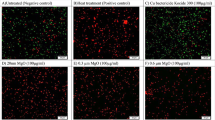Abstract
SINCE the discovery of Bordeaux mixture over 80 years ago the question has often been posed as to how the copper reaches the fungal cell in toxic concentrations when the solubility of dried Bordeaux deposits in water is so low. Of the three possible agencies for solubilizing copper, namely the atmosphere, the spore, and the host plant, the last two have been regarded as the most important and it is established that spore1,2 and leaf3,4 exudates can dissolve copper from Bordeaux spray deposits. The assumption from this work is that a soluble copper complex is formed, possibly with the amino-, hydroxy-, or dicarboxylic acids in the exudates, and this complex is accumulated by the fungal cell where it may dissociate to give free cupric ion. However, most workers have shown that the copper complexes which could possibly be formed with leaf or spore exudates are much less toxic than the free ion5–10. In fact, under conditions of high spore/copper ratios, copper can stimulate germination by leaking growth factors in the spore exudate11,12.
This is a preview of subscription content, access via your institution
Access options
Subscribe to this journal
Receive 51 print issues and online access
$199.00 per year
only $3.90 per issue
Buy this article
- Purchase on Springer Link
- Instant access to full article PDF
Prices may be subject to local taxes which are calculated during checkout
Similar content being viewed by others
References
McCallan, S. E. A., and Wilcoxon, F., Contr. Boyce Thompson Inst., 8, 151 (1936).
Wain, R. L., and Wilkinson, E. H., Ann. App. Biol., 30, 379 (1943).
Martin, J. T., and Somers, E., Nature, 180, 797 (1957).
Arman, P., and Wain, R. L., Ann. Appl. Biol., 46, 366, (1958).
Goldsworthy, M. C., and Green, E. L., J. Agric. Res., 56, 489, (1938).
Biedermann, W., and Müller, E., Phytopath. Z., 18, 307 (1951).
Horsfall, J. G., Principles of Fungricidal Action (Waltham, Mass.: Chronica Botanica Co., 1956).
Adam, A. V., and Powell, D., Phytopathology, 47, 1 (1957).
Mönch, G., Arch. Mikrobiol., 30, 231 (1958).
Tröger, R., Arch. Mikrobiol., 37, 341 (1960).
Kovàcs, A., and Garavini, C., Ricerca sci., 29, 1912 (1959).
Richardson, L. T., and Thorn, G. D., Phytopathology, 52, 865 (1962).
McCallan, S. E. A., and Miller, L. P., Adv. Pest Contr. Res., 2, 107 (1958).
Somers, E., Ann. Appl. Biol., 51, 425 (1963).
Author information
Authors and Affiliations
Rights and permissions
About this article
Cite this article
SOMERS, E. Solubilization of Copper and the Mode of Action of Bordeaux Mixture. Nature 206, 216–217 (1965). https://doi.org/10.1038/206216b0
Issue Date:
DOI: https://doi.org/10.1038/206216b0
Comments
By submitting a comment you agree to abide by our Terms and Community Guidelines. If you find something abusive or that does not comply with our terms or guidelines please flag it as inappropriate.



